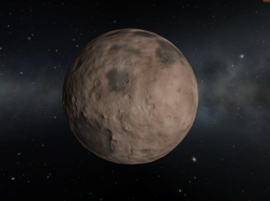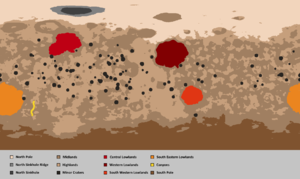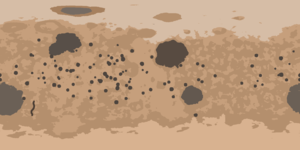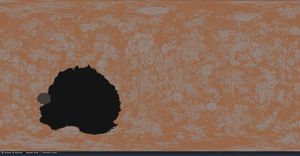Difference between revisions of "Moho"
Aceassasin (talk | contribs) |
(→KSP 2) |
||
| (153 intermediate revisions by 84 users not shown) | |||
| Line 1: | Line 1: | ||
| − | {{ | + | {{Infobox/Body}} |
| − | |||
| − | |||
| − | |||
| − | |||
| − | |||
| − | |||
| − | |||
| − | |||
| − | |||
| − | |||
| − | |||
| − | |||
| − | |||
| − | |||
| − | |||
| − | |||
| − | |||
| − | |||
| − | |||
| − | |||
| − | |||
| − | |||
| − | |||
| − | |||
| − | |||
| − | |||
| − | |||
| − | |||
| − | }} | ||
| − | '''Moho''' is the | + | '''Moho''' is the third-smallest planet and the planet closest to [[Kerbol]]. Moho has an orbital period of 102 days and an orbital velocity ranging from 12–18km/s, making it the [[celestial body]] with the shortest orbit and the fastest velocity in [[Kerbal Space Program]]. It is the [[w:Mercury (planet)|Mercury]] analogue. Moho lacks an [[atmosphere]] and natural satellites. The planet gets its name from the [[w:Mohorovičić discontinuity|''Moho''rovičić discontinuity]], the boundary between the [[w:Earth|Earth]]'s crust and mantle. |
| − | + | Moho's inclined, low, and eccentric [[orbit]] and lack of atmosphere or moons (for [[aerobraking]] and [[Tutorial: Gravity Assist|gravity assist]]s, respectively) make [[encountering]] the planet relatively difficult. Without an atmosphere to retain or block heat, Moho's daytime surface temperatures can exceed 300 °C, making [[radiator]]s an absolute necessity if any [[part]] (such as drills or engines) must be cool to operate both safely and effectively. Moho rotates very slowly, its solar day being over 100 times longer than Kerbin's, which means that reconnaissance satellites will likely wait a long time between targets, but it also means that there may be several opportunities to perform individual measurements across multiple orbits. Although Moho's close proximity to the sun increases solar panel output to 10.4x that of Kerbin's at periapsis, excessive heat can cause cooling issues for mining operations and the extremely long nights will necessitate bringing an alternative power source ([[PB-NUK Radioisotope Thermoelectric Generator|RTGs]] or [[Fuel cell|fuel cells]]) for extended surface operations. | |
| + | |||
| + | There is a [[tutorial]] for [[Traveling to Moho|traveling to Moho]]. | ||
| + | |||
| + | == In-game Description == | ||
| + | |||
| + | '''KSP 1:''' | ||
| + | {{Quote | ||
| + | | | ||
| + | <br /> | ||
| + | ''Moho figures in Kerbal mythology as a fiery place with oceans of flowing lava. In reality however, it's much less interesting. Scientists speculate about possible ways to make it "awesome like in the stories". Some of those ideas have led to new breakthroughs in aerospace technology. | ||
| + | |[[Kerbal Astronomical Society]]}} | ||
| + | |||
| + | '''KSP 2''' | ||
| + | |||
| + | {{Quote | ||
| + | |Most Moho missions crumble early on because of the logistics. It zips along an inclined, eccentric orbit, making interception a nightmare! If you make it into Moho's SOI, there's no atmosphere for aerobraking, and there's severe heat on its sunny side, due to it being tidally locked with Kerbol. But imagine beholding those craters in person!|}} | ||
== Topography == | == Topography == | ||
| − | [[ | + | Moho's surface ranges from light brown highlands to dark brown basaltic basins and a large depression called the Northern Sinkhole near the North pole (not to be confused with the [[Mohole]]). These features, together with surface reports, strongly evidence the presence of past [[w:volcanism|volcanism]]. Its highest point is in its northern hemisphere at an altitude of 6817 m. Moho's heavily eroded surface and lack of ground scatter despite there being no atmosphere suggest active [[w:space weathering|space weathering]] processes. |
| − | The | + | |
| + | Moho has a very deep well at its geographic north pole, called the [[Mohole]]. The Mohole is about 4.6 kilometers deep and 1.7 kilometers across, with a descending angle of 80 degrees. <ref>“[[thread:48006|Moho's Secrets Revealed]]” </ref> The hole is a glitch in the procedural generation of terrain; many other bodies with land at the north pole have similar bugs.<ref>https://www.youtube.com/watch?v=-e5SGynBJ4Y</ref> Despite the appearance of another hole at the geographic south pole in [[Map View]], one does not exist. | ||
| + | |||
| + | The Mohole can destroy craft and kill Kerbals that fall into it. | ||
| − | == | + | == Biomes == |
| − | + | === KSP 1 === | |
| + | [[File:MohoBiomeMap.png|thumb|none|Moho biome map (legend)]] | ||
| − | + | Moho has 12 [[biome]]s. It is one of three bodies (the other being [[Kerbin]] and [[Ike]]) that have their own North and South Pole biomes. It is dotted with Minor Craters and features four distinct Lowland Biomes. The [[Mohole]] is registered as part of the South pole despite being at the North pole. | |
| − | |||
| − | |||
| − | |||
| − | |||
| − | |||
| − | + | ==== Biome list ==== | |
| + | {{Biome list|list= | ||
| + | * North Pole | ||
| + | * Northern Sinkhole Ridge | ||
| + | * Northern Sinkhole | ||
| + | * Highlands | ||
| + | * Midlands | ||
| + | * Minor Craters | ||
| + | * Central Lowlands | ||
| + | * Western Lowlands | ||
| + | * South Western Lowlands | ||
| + | * South Eastern Lowlands | ||
| + | * Canyon | ||
| + | * South Pole}} | ||
| − | + | == KSP 2== | |
| − | == | + | === Surface Research Locations === |
| − | + | ||
| + | Surface research locations include: | ||
| + | |||
| + | * Concentric Crater | ||
| + | * Degraded Crater | ||
| + | * Lowlands | ||
| + | * Highlands | ||
| + | * Mohole MoHeart | ||
| + | * The Croissant | ||
| + | |||
| + | ==== Mohole MoHeart ==== | ||
| + | This is a discovery located at the bottom of the Mohole, a 3 km deep pit at Moho's north pole. The pit has a raised ridge, which then descends down into the planet. While some starshine or partially illuminates the Mohole on the surface, the light rapidly disappears as you approach its bottom. Landing at the bottom is difficult due to steeply sloped terrain, but is possible thanks to the low gravity of Moho. | ||
| + | |||
| + | Landing here is a side mission in KSP2 that awards considerable science points. | ||
| + | |||
| + | ==== The Croissant ==== | ||
| + | This is a discovery located on the surface in the northern hemisphere. It is a rocky outcropping that really does resemble a croissant. Landing here is a side mission in KSP2. | ||
| − | + | === Maps === | |
| − | + | ==== Biomes ==== | |
| − | + | [[File:moho_region_ui.jpg|thumb|none|Moho biome map with legend (as of v0.2.1.0 (from Orbital Survay mod))]] | |
| + | Moho currently has 4 [[biome]]s | ||
| + | * Lowland | ||
| + | * Highlands | ||
| + | * Degraded Crater | ||
| + | * Concentric Crater | ||
| + | ==== Visual map ==== | ||
| + | [[File:moho_visual.png|thumb|none|Moho visual map (as of v0.2.1.0)]] | ||
| + | [https://i.imgur.com/cKFGrCq.png Moho visual map (Imgur)] | ||
| − | == | + | == Orbital Statistics == |
| − | + | Mohosynchronous and semi-synchronous orbits are impossible — they would require altitudes of {{OrbitAltitude | period=1210000 | mass=2.53e21 | radius=250000 | factor=k }} and {{OrbitAltitude | period=605000 | mass=2.53e21 | radius=250000 | factor=k }} respectively, both of which are beyond Moho's [[sphere of influence]]. | |
== Reference Frames == | == Reference Frames == | ||
| + | {{:Moho/RefFrame}} | ||
| − | + | == Solar System Counterpart == | |
| + | Moho is the apparent [[Kerbol System]] analog of the planet Mercury. Both share a similar cratered landscape, like most bodies with little to no atmosphere. Due to the lack of an atmosphere to retain heat, Moho and Mercury are freezing on the night side and, relative to Earth, extremely hot on the day side. Both planets are also the closest to their respective stars, share a similar orbital eccentricity and lack natural satellites. | ||
| − | + | However, Moho has a brown surface, while Mercury has a dark grey surface. In addition, Mercury has a tenuous atmosphere of about 10⁻¹³ kPa while Moho has no atmosphere; although, a pressure of 10−13<sup></sup> kPa (≃ 10<sup>–15</sup> atm) would be rendered "unmeasurable" by the [[PresMat Barometer]] and register in KSP as a vacuum. However, Moho did have a super-heated atmosphere up until 0.18. | |
| − | |||
| − | |||
| − | |||
| − | |||
| − | |||
| − | |||
| − | |||
| − | |||
| − | |||
| − | |||
| − | |||
| − | |||
| − | |||
| − | |||
| − | |||
| − | |||
| − | |||
== Gallery == | == Gallery == | ||
<gallery> | <gallery> | ||
| − | Moho_landing.png|A successful landing at Moho. Note the engines still overheating. | + | Moho_800_map.gif | A topographic height map of Moho as at Version 0.18.2 made with the ISA MapSat plugin. |
| + | Moho_landing.png | A successful landing at Moho pre-0.18. Note the engines still overheating. | ||
| + | Moho Landing 0.23.5.png | A successful landing in 0.23.5, after Moho's color was changed and its superheated atmosphere was removed. The walls of the basins are quite steep. | ||
| + | Probewedge.jpg | A probe wedged in the 5 km deep lava well at the north pole. | ||
| + | Moho_flyby.png | A probe performing a Moho flyby. | ||
| + | HannyNMohole.png | Hanny Kerman wedged in the Northern [[Mohole]] sideways. Lots of orientation jittering was observed. | ||
| + | EnteringMohoOrbit.png | A spacecraft carrying a probe decelerates to enter into orbit around Moho. Vessels pick up a lot of speed approaching this inner planet. | ||
| + | Screenshot153 moho vol.png | A footage about pre 0.18 moho.Note that there is a giant volcano which is 12 km high. | ||
| + | Screenshot142.png | Ronfrod Kerman is watching the landscapes. Moho's red atmosphere is very clear on the horizon. | ||
| + | Screenshot491.png | A 0.17 Moho land-and-return challenge craft is attempting a landing. note the red landscape and a giant volcano | ||
| + | File:Heatseeker Poles.png|thumb|A probe flying above the jagged polar terrain of Moho. | ||
</gallery> | </gallery> | ||
== Changes == | == Changes == | ||
| − | ; | + | ;[[0.90]] |
| − | *Entirely changed more cratered surface. | + | * Added biomes |
| − | *Color changed from red to brown. | + | ;[[0.21]] |
| − | *No more superheated atmosphere. | + | *New, procedurally generated, textures added, with higher detail craters. |
| − | ; | + | ;[[0.18]] |
| + | * Entirely changed more cratered surface. | ||
| + | * Color changed from red to brown. | ||
| + | * No more superheated atmosphere. | ||
| + | * No longer tidally locked. | ||
| + | * Mass reduced. | ||
| + | ;[[0.17]] | ||
* Initial Release | * Initial Release | ||
== Notes == | == Notes == | ||
<references /> | <references /> | ||
| − | |||
{{Celestial Bodies}} | {{Celestial Bodies}} | ||
[[Category:Celestials]] | [[Category:Celestials]] | ||
[[Category:Planets]] | [[Category:Planets]] | ||
Latest revision as of 18:42, 20 March 2024
| Moho | ||
| Moho as seen from orbit. | ||
| Planet of Kerbol | ||
| Orbital Characteristics | ||
| Semi-major axis | 5 263 138 304 m [Note 1] | |
| Apoapsis | 6 315 765 981 m [Note 1] | |
| Periapsis | 4 210 510 628 m [Note 1] | |
| Orbital eccentricity | 0.2 | |
| Orbital inclination | 7 ° | |
| Argument of periapsis | 15 ° | |
| Longitude of the ascending node | 70 ° | |
| Mean anomaly | 3.14 rad (at 0s UT) | |
| Sidereal orbital period | 2 215 754 s | |
| 102 d 3 h 29 m 14.2 s | ||
| Synodic orbital period | 2 918 346.4 s | |
| Orbital velocity | 12 186 - 18 279 m/s | |
| Physical Characteristics | ||
| Equatorial radius | 250 000 m | |
| Equatorial circumference | 1 570 796 m | |
| Surface area | 7.8539816×1011 m2 | |
| Mass | 2.5263314×1021 kg | |
| Standard gravitational parameter | 1.6860938×1011 m3/s2 | |
| Density | 38 599.500 kg/m3 | |
| Surface gravity | 2.70 m/s2 (0.275 g) | |
| Escape velocity | 1 161.41 m/s | |
| Sidereal rotation period | 1 210 000.0 s | |
| 56 d 0 h 6 m 40 s | ||
| Solar day | 2 665 723.4 s | |
| 123 d 2 h 28 m 43.4 s | ||
| Sidereal rotational velocity | 1.2982 m/s | |
| Synchronous orbit | Outside sphere of influence | |
| Sphere of influence | 9 646 663.0 m [Note 1] | |
| Atmospheric Characteristics | ||
| Atmosphere present | No | |
| Scientific multiplier | ||
| Surface | 10 | |
| Splashed | N/A | |
| Near space | 8 | |
| Outer space | 7 | |
| Recovery | 7 | |
|
| ||
Moho is the third-smallest planet and the planet closest to Kerbol. Moho has an orbital period of 102 days and an orbital velocity ranging from 12–18km/s, making it the celestial body with the shortest orbit and the fastest velocity in Kerbal Space Program. It is the Mercury analogue. Moho lacks an atmosphere and natural satellites. The planet gets its name from the Mohorovičić discontinuity, the boundary between the Earth's crust and mantle.
Moho's inclined, low, and eccentric orbit and lack of atmosphere or moons (for aerobraking and gravity assists, respectively) make encountering the planet relatively difficult. Without an atmosphere to retain or block heat, Moho's daytime surface temperatures can exceed 300 °C, making radiators an absolute necessity if any part (such as drills or engines) must be cool to operate both safely and effectively. Moho rotates very slowly, its solar day being over 100 times longer than Kerbin's, which means that reconnaissance satellites will likely wait a long time between targets, but it also means that there may be several opportunities to perform individual measurements across multiple orbits. Although Moho's close proximity to the sun increases solar panel output to 10.4x that of Kerbin's at periapsis, excessive heat can cause cooling issues for mining operations and the extremely long nights will necessitate bringing an alternative power source (RTGs or fuel cells) for extended surface operations.
There is a tutorial for traveling to Moho.
Contents
In-game Description
KSP 1:
| “ | Moho figures in Kerbal mythology as a fiery place with oceans of flowing lava. In reality however, it's much less interesting. Scientists speculate about possible ways to make it "awesome like in the stories". Some of those ideas have led to new breakthroughs in aerospace technology. |
” |
KSP 2
| “ | Most Moho missions crumble early on because of the logistics. It zips along an inclined, eccentric orbit, making interception a nightmare! If you make it into Moho's SOI, there's no atmosphere for aerobraking, and there's severe heat on its sunny side, due to it being tidally locked with Kerbol. But imagine beholding those craters in person! | ” |
Topography
Moho's surface ranges from light brown highlands to dark brown basaltic basins and a large depression called the Northern Sinkhole near the North pole (not to be confused with the Mohole). These features, together with surface reports, strongly evidence the presence of past volcanism. Its highest point is in its northern hemisphere at an altitude of 6817 m. Moho's heavily eroded surface and lack of ground scatter despite there being no atmosphere suggest active space weathering processes.
Moho has a very deep well at its geographic north pole, called the Mohole. The Mohole is about 4.6 kilometers deep and 1.7 kilometers across, with a descending angle of 80 degrees. [1] The hole is a glitch in the procedural generation of terrain; many other bodies with land at the north pole have similar bugs.[2] Despite the appearance of another hole at the geographic south pole in Map View, one does not exist.
The Mohole can destroy craft and kill Kerbals that fall into it.
Biomes
KSP 1
Moho has 12 biomes. It is one of three bodies (the other being Kerbin and Ike) that have their own North and South Pole biomes. It is dotted with Minor Craters and features four distinct Lowland Biomes. The Mohole is registered as part of the South pole despite being at the North pole.
Biome list
|
KSP 2
Surface Research Locations
Surface research locations include:
- Concentric Crater
- Degraded Crater
- Lowlands
- Highlands
- Mohole MoHeart
- The Croissant
Mohole MoHeart
This is a discovery located at the bottom of the Mohole, a 3 km deep pit at Moho's north pole. The pit has a raised ridge, which then descends down into the planet. While some starshine or partially illuminates the Mohole on the surface, the light rapidly disappears as you approach its bottom. Landing at the bottom is difficult due to steeply sloped terrain, but is possible thanks to the low gravity of Moho.
Landing here is a side mission in KSP2 that awards considerable science points.
The Croissant
This is a discovery located on the surface in the northern hemisphere. It is a rocky outcropping that really does resemble a croissant. Landing here is a side mission in KSP2.
Maps
Biomes
Moho currently has 4 biomes
- Lowland
- Highlands
- Degraded Crater
- Concentric Crater
Visual map
Orbital Statistics
Mohosynchronous and semi-synchronous orbits are impossible — they would require altitudes of 18 182.08 km and 11 361.48 km respectively, both of which are beyond Moho's sphere of influence.
Reference Frames
| Time warp | Minimum Altitude |
|---|---|
| 1× | Any |
| 5× | 10 000 m |
| 10× | 10 000 m |
| 50× | 30 000 m |
| 100× | 50 000 m |
| 1 000× | 100 000 m |
| 10 000× | 200 000 m |
| 100 000× | 300 000 m |
Solar System Counterpart
Moho is the apparent Kerbol System analog of the planet Mercury. Both share a similar cratered landscape, like most bodies with little to no atmosphere. Due to the lack of an atmosphere to retain heat, Moho and Mercury are freezing on the night side and, relative to Earth, extremely hot on the day side. Both planets are also the closest to their respective stars, share a similar orbital eccentricity and lack natural satellites.
However, Moho has a brown surface, while Mercury has a dark grey surface. In addition, Mercury has a tenuous atmosphere of about 10⁻¹³ kPa while Moho has no atmosphere; although, a pressure of 10−13 kPa (≃ 10–15 atm) would be rendered "unmeasurable" by the PresMat Barometer and register in KSP as a vacuum. However, Moho did have a super-heated atmosphere up until 0.18.
Gallery
Hanny Kerman wedged in the Northern Mohole sideways. Lots of orientation jittering was observed.
Changes
- Added biomes
- New, procedurally generated, textures added, with higher detail craters.
- Entirely changed more cratered surface.
- Color changed from red to brown.
- No more superheated atmosphere.
- No longer tidally locked.
- Mass reduced.
- Initial Release














